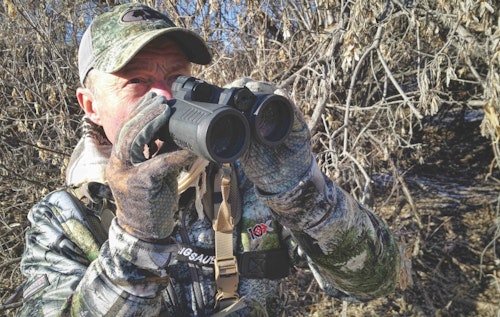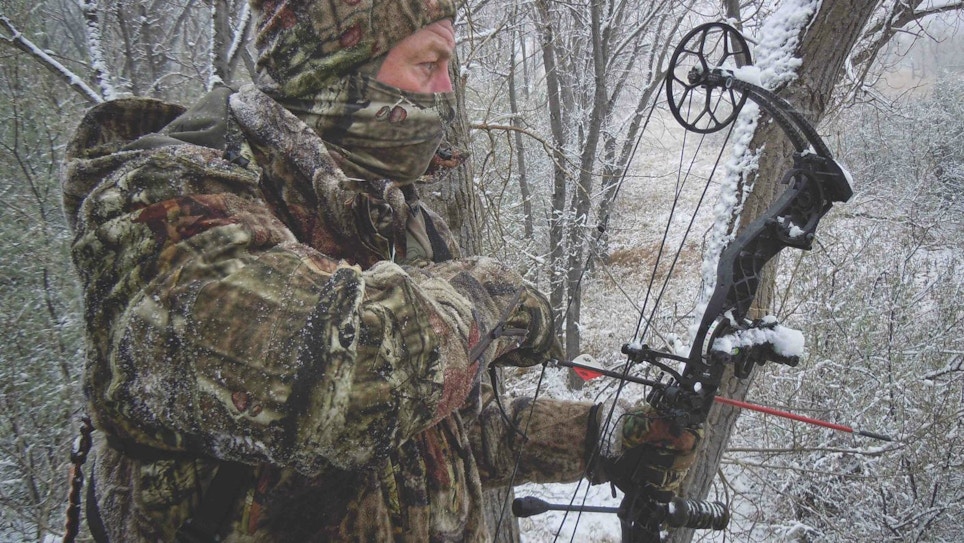You might be surprised at the quiet transition taking place in the late-season game plan of many whitetail bowhunters. Tradition dictates you put your past scouting to use, targeting a whitetail buck’s homeland. By putting in as much time as you can, morning and evening, the odds increase of a close encounter on that field-edge stand you prepped months ago for a clover-addicted buck. Finally, dedicated bowhunters skip the potential bonus of an antlerless prize to avoid spooking any buck opportunity.
Instead, many are modifying their hunting rituals. It seems counterintuitive to make a change in the middle of the big game, but nearly every coach attempts to triumph by introducing surprise plays, especially as the two-minute warning nears. To switch it up, here are a few ideas.
Scout More; Hunt Less
Once the season opens, it’s customary to push aside scouting and make hunting a priority. You’ve spent spring, summer and early fall behind your binocular, and skimming through thousands of trail camera images. The evidence is clear. You have a good idea of the bedroom, byway and buffet preference of your target buck.
Those trends tend to stay firm throughout the fall with the one exception being the breeding window. Despite tradition, when the excitement of the rut subsides, a new pattern could emerge. A timeout could be the tactic to employ with new emphasis on scouting.
Cordell Turner operates Circle Cross Outfitters in southwest Iowa and northwest Missouri. He uses his farming background and hunting experience to put his clients in range of whitetails from the start of the season into the snowy end game. He understands that once the rut wanes, bucks take on a new mission to survive to spring after losing between 20 and 25 percent of their body weight from rutting.
“I 100 percent believe that bucks change their pattern in the late season,” said Turner. “At that time of year they are searching for a good food source and thick cover. They are run down after the rut and are looking for a sanctuary to feel safe in, but they also want to be close to a reliable food source.”
To locate bucks adjusting to security and safety, Turner recommends scouting more than hunting. Whitetails will turn to high-energy and nutritious foods to restore lost body mass, but Turner understands that after being hunted all fall they have an exceedingly skittish nature. His advice is to stay back, scout food, check cameras sparingly and when a pattern emerges, then it’s time to hunt.
Weary bucks routinely change to high-energy food sources such as corn, soybeans and turnips, or other forms of brassicas in food plots. Native browse is also highly attractive now as ag offerings dwindle. Regional favorites vary, but ash, sumac and white cedar are a few to consider as you review new opportunistic ambush locations.
Skip Mornings
“Are you kidding?” I questioned my host. “Why would I skip the morning hunt?” That exchange took place more than a decade ago, but was an eye-opener for me. The landowner hosting me on the hunt outlined the whitetail feeding pattern on the property and clearly laid out a case of why I shouldn’t attempt a morning hunt. Trying to get into the best stands would be hunting suicide as I’d drive every deer off the fields in the dark while sneaking into position.
It’s a lesson I recall on every hunt as I review stand options and the consequences of my presence combined with what’s happening on the ground. If you simply can’t avoid a morning outing, put your time to good use behind a binocular. Turner follows a similar deer doctrine in the late season.
“I believe it’s a wise decision to avoid morning hunts during late season,” he said. “You risk bumping feeding deer and those deer on their way back to bedding cover. I always recommend getting up, getting a good breakfast and getting out midday for the prime afternoon ambush between the food source, and bedding.”

Split Your Time
Even if you skip the morning hunt, you may want to modify your ambush further. In most parts of whitetail country, deer have been hunted 90 days or more by the time the late-season window arrives. Would you waltz around in broad daylight after feeling that heat?
Consider moving your ambush operations away from the big fields to travel conduits behind the screen of timber. This tactic mimics pre-rut practices where you are inclined to hunt just inside a stand of timber, adjacent to a field. Pre-rut bucks are anxious to check for does, but not anxious enough to risk exposure to danger. Post-rut bucks hold up short, too. They could delay their entrance until the last several minutes of shooting light or not show until after dark.
“Targeting a buck that you can’t find from earlier or that is only showing up on your cameras at night can be tricky this time of year,” Turner said. “My suggestion is to locate the staging area where those bucks are spending their last 15 minutes or so before sunset. It’s the perfect ambush location to meet a buck before it walks out to its final food source.”
This tactic also includes some gamble. If you move in too deep into cover, you might bump deer. If you set up too close to the food, you may not encounter a cautious buck. Turner recommends that you proceed with caution, but look for middle ground. An area that holds native vegetation for browsing but also offers concealment is ideal. Even if you find the perfect zone, Turner warns about being too aggressive: “This time of year you will find a lot of deer in one area, so I think it’s best to stay back from the bedding with a buffer zone between you and it. This is another reason that it is so crucial to do your scouting beforehand.”
Focus on the Freezer
There are times, even though a buck is confirmed to be living on a property, that you simply can’t kill him. A prime example is when a balmy forecast overcomes a region. Despite bucks being worn down to the condition of an Everest climber, if the sun shines and temperatures soar above freezing, deer simply don’t need to eat during dangerous, daylight hours. They can get the nutritional boost they need during the longer nighttime hours and hole up during the day while soaking up the rays.
I’ve encountered that scenario repeatedly during December and January hunts. Trail cameras stack up the nocturnal activity of deer, while crows flapping in front of the camera rack up daytime images. Don’t walk off the field yet. There are opportunities for deer management and possibilities for landowner relationship-building. In brief, hunt antlerless deer. The venison tastes the same and many landowners appreciate the removal of extra deer before they become a nuisance raiding winter food reserves for livestock. Plus, you continue to hone your hunting skills.
Turner agrees: “Late season is a fantastic time to go with friends and family. You can always count on a doe or two to show up on a good food source. Although it may not be the trophy whitetail you had set out to hunt all season, it’s still a great way to aid in herd management and to fill the freezer. On top of that, you may even get lucky and have a buck still roaming around during the late rut. Even if you feel that your plans are unraveling, there is never a moment lost in the outdoors.”
Images by Mark Kayser







